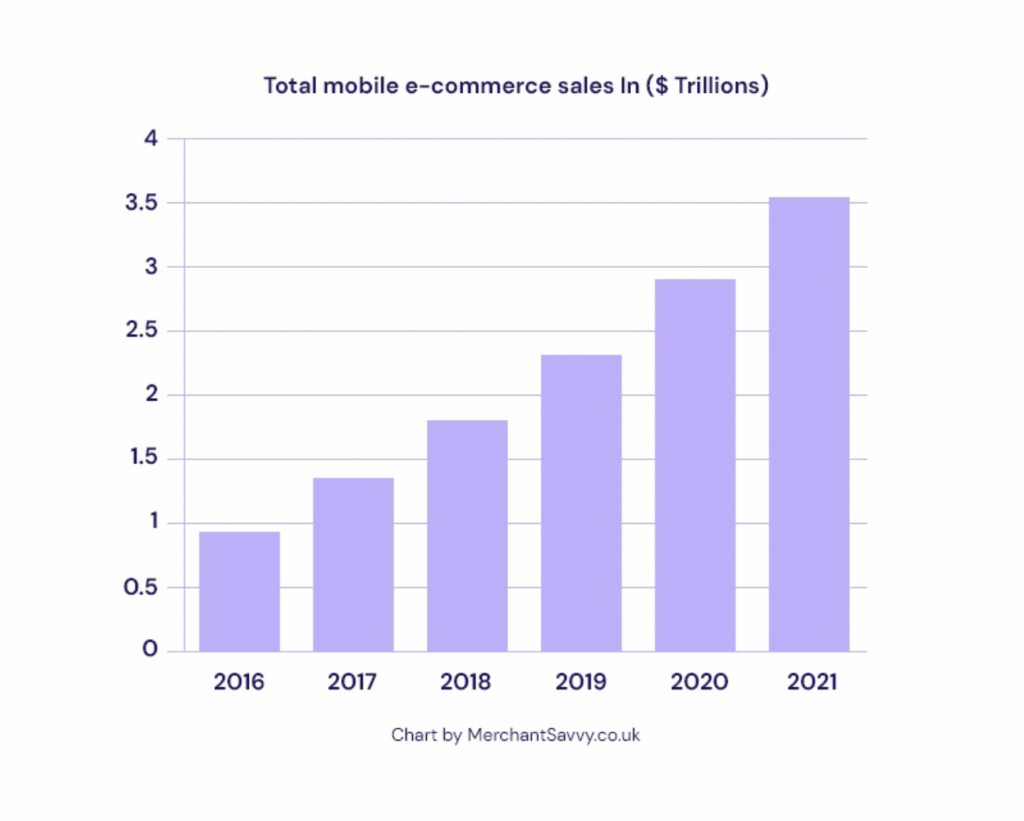Way back in the yesteryears of the early 2000s and 2010s, there was a genuine debate over whether it was cost effective to build a mobile app for your e-commerce business. Now there’s no more debate – you NEED that app. Just look at how mobile ecommerce sales have ballooned in the last 5 years alone!

So you know you need to build your own app for ios/android, but maybe you don’t know how to build an app. Or beyond that, you certainly don’t know how to build an app for free, or what goes into making your app as cost effective as possible. Well, we’re here to help!
There are a number of factors that affect just how cost effective your app can be, so we’ll go through a few of them to see what kind of options work best for you.
What are the goals for your app?
The development process for building an app, using app building software or building your own from scratch, can vary tremendously based on where you’re coming from and where you’re going. What’s your current mobile conversion rate? Are you planning to prioritize loyalty, conversion, optimization? All of the above?
Basically you need to determine what the KPIs for your app should be, and from there what features are most likely to lead to you hitting – or surpassing – those KPIs. And of course, what data will you need to ensure that your features run properly. In practice, this means that you keep close track of conversion rates, customer lifetime value, customer retention rate, average value order, net profit, cart abandonment rate, and the number of orders. From there, depending on what your goals are, you make small tweaks based on what your data is telling you to optimize performance to hit your goals.
What type of technology works for you?
Here we’re mostly comparing PWAs and Native apps. PWAs, or Progressive Web Apps, have much of the same functionality of native apps except they run in the web browser. Native apps are standard apps that you download. Many people see PWAs replacing native apps over time, but as things stand now there are some fairly clear pros and cons.
For starters, native apps still hold a little more credibility, so if you want to build a name for your brand you’ll probably want a high functioning native app. Native apps also can use more of the smartphone’s features, so if your product relies more on high computing power – or if it relies on geofencing and sensor/detection, then native apps are the way to go. Essentially, if you’re trying to get your product market fit, then native apps are probably what you’ll be looking at.
PWA’s are cheaper, for people who are looking to build an app for free or cheap. They work on SEO like any other website to reach a wider audience across all platforms whereas for native apps you have to build an ios/android app. But given that this is much more how people consume their content these days, for the present, native apps are more or less an imperative.

Which features will you put in your app
If you’re building your own app, or wondering how to build an app for free – there are some very basic features that are not overly complex to develop. A few completely basic ideas that every single app must have include
- Payment gateway
- Checkout
- Order and tracking
- User/guest login & registration
- Product catalogues
But from there you’ll find significant differences that can be costly to implement.
- Social media integration?
- Push notifications?
- Chatbot or in-app chat?
- Search functions and filters?
- Product/Customer reviews?
- How many different payment options?
- Wish lists?
- Etc.
Each feature you add with add cost as well, so it’s up to you to decide whether extra features are necessary to achieve your goals or not. If you’re not sure, probably the easiest option is to build an app as simply as possible at first – possibly using ad building software – and then update it with more advanced features as the business grows.
How much will you have to maintain your app?
Many people forget about this, but it’s crucial to the cost of ecommerce app development. If you’re building an ios/android app, you’ll need to plan in regular updates so your app is constantly optimized. As the platform updates, you’ll likely need to update the app as well, so it’s important to fit that into the budget constraints from the get-go so there aren’t any surprises.
How are you planning on monetizing the app?
The two essential strategies here are
- Business monetization model – this is where you sell your own products through your own app.
- Aggregator Business model – this is the “Amazon model,” where other brands sell their products or services on your app.
The features you’ll want to incorporate in your app will depend on how your monetization schemes operate.
Key Takeaways
So you’ve probably got a sense that the cost can vary WILDLY, and you’re right. A 2021 Medium.com article reckons that building a successful ecommerce app costs anywhere between $30,000 and $700,000, and that’s not to say that a $30,000 app is a bad/worse product. It’s just one with fewer features.
It really is up to you to decide what features matter most to you. Probably working with a no code app builder can help you decide what features will be most cost effective for your goals, and help you zone in on the KPIs that’ll matter most for you. You’ll want to figure out which technologies are most important for you, and build an app that caters specifically to your needs to make sure that it’s the most cost effective app for you and your business.






